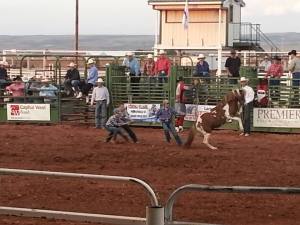Have you thought about it or seen an article on it – the science of rodeo? As July is prime rodeo season in the United States: Fourth of July Weekend, Cheyenne Frontier Days, and Cavalcade just to name a few, it seems like an appropriate question to ask. And, as it turns out, while there is lots of science going on; there is not a lot of it published as “rodeo science.”
Here are some prime examples of science at work at the rodeo:
Animal Breeding Programs – Rodeo involves two types of athletes, the human and the animal. The “rough stock,” the bucking bulls and broncs are highly valued animals. Additionally, for the timed events humans team up with their animal partner, typically a very well trained and bred horse. Additionally, there are cattle, goats or sheep that are used in the timed or other events. Thus, there is a great deal of science going on to ensure good genetics are passed on to the next generation of livestock. For the “rough stock,” there are numerous “born-to-buck” programs to breed future champion broncs and bulls. In these programs, the genetics are carefully monitored and tracked.
Nutrition and Veterinary Science – Once the animal is physically in the world, care is essential to keeping the animal healthy. Animal nutrition specific to the animals breed and work is complicated science. Add to that the variety of animals used in rodeo, the nutritional needs of the individual animal competitors can become a full time job for the rodeo stock contractor. This is in addition to the veterinary care that these animals receive to ensure they are in good health while on the rodeo circuit.
As for the human competitor’s partners, these horses receive constant care and attention during training as well as the rodeo season. Their diets and health are monitored daily by their teammate and are routinely seen by veterinarians. Horses that travel are required to maintain certain paperwork signed by veterinarians and are required to show that paperwork prior to entering various rodeo or fair grounds. (Olympic horses that travel outside the United States have what are known as equine passports so that they can travel to various competitions.)
Safety Science – In the early days of rodeo, protective gear was a good saddle, a cowboy hat, boots, jeans, and a long sleeve shirt. Today, you see several different types of protective gear – both for the cowboy or cowgirl and the animals. For the horses used by the cowboy or cowgirl, you may see specialized boots, shoes, and other gear to help protect the horse’s legs and feet. For the roping steers, you will see horn wraps. Horn wraps are used to protect the steer from injury due to the rope. Then there is the “rough stock” rider’s gear: gloves, vests, neck protection, and safety helmets. This equipment has become more and more “high tech” with the advent of advanced materials and information on sports injuries from other sports. Even the cowgirls wear shin guards to protect their legs when running the barrels. This doesn’t even address the equipment worn by the “bullfighters” or your chute workers.
Equipment – There is a variety of equipment that is used in rodeo events; from the hand hold rigging for the bareback bronc to the ropes used in steer or calf roping. (Did you know that there are ropes designed for the person who throws left-handed versus right-handed?) The saddles that are used by the steer wrestlers will be different than those used by the barrel racers. The ropes, riggings, and other equipment are designed for the specific uses and are always being modified and improved.
In addition to this “hidden” science, there is obvious evidence of physics. What goes up – must come down. Or, pure examples of Newton’s Laws – for every action there is an equal and opposite reaction or an object in motion stays in motion unless acted upon. As the horse or bull bucks, the cowboy has to react to the changes in momentum and the forces that the animal is generating in order to stay on for those 8 seconds. If not, he is going to experience gravity usually in a pretty spectacular manner.
The human rodeo competitor not only has to account for his/her own motion and reactions but for those of the other competitors – the horse, the cattle, or the bull. These competitors do more complex calculations in a brief 4 seconds for the ropers, 8 seconds for the “rough stock” riders, and 15 seconds for the barrel racers, than most theoretical physicists will do in their entire lives. The only difference is that rodeo competitor never writes it down and if they are really good gets to take home a buckle and maybe a bit of prize money.
